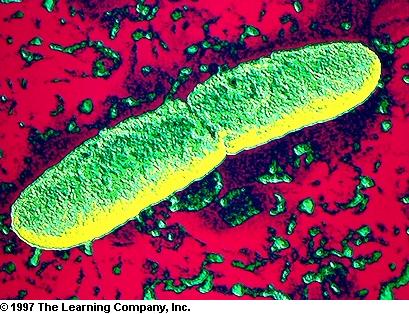
The Bubonic Plague swept across Europe like a black storm, at the time the scurge of the land. The "Black Plague", as it was often called, struck in 1348, in Italy first, which at the time was opening tradeways to Asia. The Bubonic Plague struck more recently in Surat, India 1994, and Nevada County in 1997.
Infection
The Bubonic Plague is caused by the bacterium, Yersinia pestis. A bacillus with incredible killing power. One bacillus alone is enough to infect a human. The bacterium's lifecycle begins in a rat's blood. The fleas that host upon the rat, consume of it's blood allowing growth of the bacteria in the flea's gut. The flea's gut eventually becomes clogged with bacteria. When the flea bites a new host, it will regurgitate bacteria into the open wound. The lifecycle of Yersinia pestis generally incorporates Xenopsylla cheopis, the rodent flea, or Pulex irritans the human flea. The mortality rate amoung victums is high, up to 75% in untreated cases. Since there where no anti-bacterial medication in 1348, all cases were untreated.
Strains
There are many strains of the plague, including bubonic, pneumonic, septicaemic and pestis minor. All are severe and must be treated quickly. With the Pneumonic Plague the bacteria invade the lungs. The lungs then fill with a frothy bloody liquid that is easily spread from person to person. With the Septicaemic Plague the balcilli invade the bloodstream. Within a few hours the victum has a heart attack, this all happens so quickly that the buboes rarely have a chance to form. The last major strain of the plague is pestis minor, this strain is not fatal but is very discomforting. Buboes form as well as some other symptoms of the plague including headaches, fever and chills.

Symptoms
The most unique symtom of the Bubonic Plague and it's relatives, is the buboes, the swollen lymph nodes. These occur particularly at in the groin and under the armpits, sometimes swelling to the size of an apple. The buboes ooze blood and pus, as they grow in size and eventually burst. The victums die in immense pain. During this process blood vessels break to cause internal bleeding. The dried blood under the skin turns black, hence the name "Black Plague" Other symptoms include, fever, headache, and pain in the lymph nodes which may be accompanied by lethargy, slurred speech, vertigo and insomnia. In a great number of cases, the area around the flea's bite forms a blister, purplish in color. It is the Bubonic plague that is refered to in the nursery rhyme, "Ring Around the Rosy", because of the symptoms listed above.
Diagnosis
Doctors and physicians can diagnose the plague, by it's symtoms. In later cases, pain in the lymph nodes begins, then blood vessels begin to break, and the buboes form. Often the Bubonic Plague today is spread by contact with rodents. The rodent populations still harbors fleas that bear the Yersinia pestis. However the gestation period of the plague takes two to six days, before any symptoms begin.
Treatment
Antibotics have proven to be very effective against the Bubonic Plague. If a person is suspected to be infected, the person is treated with tetracycline and streptomycin. It is common practise to get an immunization to the Bubonic Plague before visiting a country where it is an epidemic.
[search] [notes] [papers] [articles] [zine] [links] [forum] [chat] [about] [disclaimer] [main]